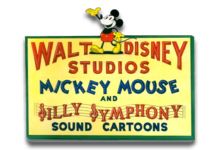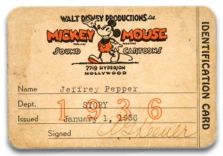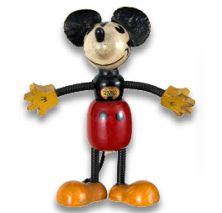Saturday at the Archives: Stargazing at Mickey's Gala Premier
Stargazing at Mickey's Gala Premier
By Jeffrey Pepper
Originally published August 5, 2008
Who was who in Hollywood in 1933? You need only look as far as the Mickey Mouse cartoon Mickey's Gala Premier for the answers. Released on July, 1, 1933, it featured over forty caricatures of motion picture celebrities. In the short, all of Tinseltown turns out for the premiere of "Galloping Romance," a short-within-the short remake of Gallopin' Gaucho.

The momentous event was held at the famous and now iconic Grauman's Chinese Theater, located at 6925 Hollywood Boulevard. Famous for its forecourt celebrity footprints in cement, the theater was built by showman Sid Grauman, whose partners in the endeavor included Mary Pickford, Douglas Fairbanks and Howard Schenck. It opened on May 18, 1927 with the premiere of the Cecil B.DeMille film
The King of Kings. In 1989, the theater's front facade and forecourt were recreated as the entrance to the Great Movie Ride at the Disney-MGM Studios in Walt Disney World.
 Mickey's Gala Premier
Mickey's Gala Premier was just five years removed from Hollywood's silent era, and so it's not surprising that numerous silent film stars are featured in the short. Director Burt Gillette and his crew reached back nearly two decades when they included five of the Keystone Cops. Numerous individuals throughout the silent era were members of Mack Sennett's group of slapstick players.
Mickey's Gala Premier showcased four of the more famous officers: Ben Turpin, Ford Sterling, Max Swain and Chester Conklin. The Cop between Swain and and Conklin has been identified by some sources as Harry Langdon. Langdon was a silent film comedian who worked for Mack Sennett but was never cast as a Keystone Cop.

Another famous silent film comedian, Harold Llyod, is joined at the radio microphone by actors Edward G. Robinson, Adolf Menjou and Clark Gable. Robinson appears as the character Rico from his 1931 movie
Little Caesar.

Three of the era's best known starlets took their turn at the microphone: Jean Harlow, Joan Crawford and Bette Davis. Crawford appeared in the costume of her character Sadie Thompson from the 1932 film
Rain.

The biggest draw at the box office in 1933 was Marie Dressler who appears in the cartoon with her frequent co-star Wallace Berry. The two had then recently worked together in the films
Dinner at Eight and
Tugboat Annie. Their most famous pairing was the 1930 movie
Min and Bill, for which Dressler won an Academy Award for Best Actress. That movie was also the inspiration for Min and Bill's Dockside Diner, a counter-service restaurant at Disney's Hollywood Studios.

Famous then and famous now are the Marx Brothers--Groucho, Harpo, Zeppo and Chico--and Stan Laurel and Oliver Hardy.

In his guise as the Little Tramp, Charlie Chaplin attempts to sneak past theater owner Sid Grauman.

Eddie Cantor appears in his role from
The Kid from Spain, released in 1932. Maurice Chevalier and Jimmy Durante also take turns at the radio microphone. In the 1960s, Chevalier would appear in the Disney live-action films
In Search of the Castaways and
Monkeys Go Home. He also recorded the title song for
The Aristocats shortly before his death in early 1972.

The Barrymore siblings, Lionel,Ethel and John, appear in their roles from the 1932 movie
Rasputin and the Empress.

The perpetually morose Buster Keaton does not share a laugh with famous big mouth Joe E. Brown.

Helen Hayes had just won an Academy Award in 1931 for her performance in
The Sin of Madelon Claudet. She is seated nearby to Chester Morris, Gloria Swanson, George Arliss and William Powell. The following year, Powell would assume his most famous role of Nick Charles in
The Thin Man. Morris would become famous a decade later for his series of Boston Blackie movies.

Classic monsters Dracula, Mister Hyde and the Frankenstein monster, as portrayed by Bela Lugosi, Fredric March and Boris Karloff respectively, display their more jovial sides.

Bert Wheeler and Robert Woolsey are largely unremembered today, despite being one of the most popular comedy acts of the 1930s. Ed Wynn is well known to Disney fans for his roles in films such as
Mary Poppins,
That Darn Cat,
The Gnome-Mobile and
Alice in Wonderland.

Mae West recreates her persona from the movie
She Done Him Wrong. She invites Sid Grauman to "Come up and see me sometime." Greta Garbo was one of the decade's most famous leading ladies.

Will Rogers lasso's Mickey while Douglas Fairbanks is overcome with laughter and begins rolling in the aisle. Rogers appears in the The American Adventure at EPCOT.

Disney animators were none too kind when they created this caricature of Will H. Hays. Famous for the Hays Code, he was the first president of the Motion Picture Producers and Distributors of America, the forerunner of the current MPAA. He was known in Hollywood as the "Censorship Czar," thus explaining his costumed appearance in the cartoon.

And who are these three gentlemen standing next to Groucho Marx in one of the shorts final scenes? The one on the right bears a very strong resemblance to certain famous cartoon-maker of the era. Hmm . . .
Images © Walt Disney Company




































































